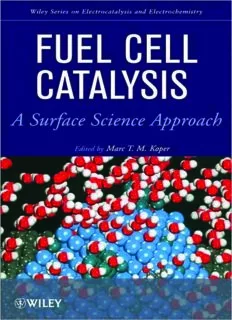
Fuel cell catalysis: a surface science approach PDF
Preview Fuel cell catalysis: a surface science approach
FUEL CELL CATALYSIS WILEY SERIES ON ELECTROCATALYSIS AND ELECTROCHEMISTRY AndrzejWieckowski,SeriesEditor FuelCellCatalysis:ASurfaceScienceApproach,EditedbyMarcT.M.Koper ElectrochemistryofFunctionalSupramolecularSystems,MargheritaVenturi, PaolaCeroni,andAlbertoCredi CatalysisinElectrochemistry:FromFundamentalstoStrategiesforFuelCell Development,ElizabethSantosandWolfgangSchmickler FuelCellScience:Theory,Fundamentals,andBiocatalysis,AndrzejWieckowski andJensNorskov FUEL CELL CATALYSIS A SURFACE SCIENCE APPROACH Edited by Marc T. M. Koper The Wiley Series on Electrocatalysis and Electrochemistry Copyright#2009byJohnWiley&Sons,Inc.Allrightsreserved PublishedbyJohnWiley&Sons,Inc.,Hoboken,NewJersey PublishedsimultaneouslyinCanada Nopartofthispublicationmayberepoduced,storedinaretrievalsystem,ortransmittedinanyformor byanymeans,electronic,mechanical,photocopying,recording,scanning,orotherwise,exceptas permittedunderSection107or108ofthe1976UnitedStatesCopyrightAct,withouteithertheprior writtenpermissionofthePublisher,orauthorizationthroughpaymentoftheappropriateper-copyfee totheCopyrightClearanceCenter,Inc.,222RosewoodDrive,Danvers,MA01923,(978)750-8400, fax(978)750-4470,oronthewebatwww.copyright.com.RequeststothePublisherforpermission shouldbeaddressedtothePermissionsDepartment,JohnWiley&Sons,Inc.,111RiverStreet,Hoboken, NJ07030,(201)748-6011,fax(201)748-6008,oronlineathttp://www.wiley.com/go/permission. LimitofLiability/DisclaimerofWarranty:Whilethepublisherandauthorhaveusedtheirbesteffortsin preparingthisbook,theymakenorepresentationsorwarrantieswithrespecttotheaccuracyor completenessofthecontentsofthisbookandspecificallydisclaimanyimpliedwarrantiesof merchantabilityorfitnessforaparticularpurpose.Nowarrantymaybecreatedorextendedbysales representativesorwrittensalesmaterials.Theadviceandstrategiescontainedhereinmaynotbesuitable foryoursituation.Youshouldconsultwithaprofessionalwhereappropriate.Neitherthepublishernor authorshallbeliableforanylossofprofitoranyothercommercialdamages,includingbutnotlimitedto special,incidental,consequential,orotherdamages. Forgeneralinformationonourotherproductsandservicesorfortechnicalsupport,pleasecontact ourCustomerCareDepartmentwithintheUnitedStatesat(800)762-2974,outsidetheUnitedStates at(317)572-3993orfax(317)572-4002. Wileyalsopublishesitsbooksinvarietyofelectronicformats.Somecontentthatappearsinprintmay notbeavailableinelectronicformats.FormoreinformationaboutWileyproducts,visitourwebsiteat www.wiley.com. LibraryofCongressCataloging-in-PublicationData: Fuelcellcatalysis:asurfacescienceapproach/editedbyMarcKoper. p.cm.—(TheWileyseriesonelectrocatalysisand electrochemistry) Includesindex. ISBN978-0-470-13116-9(cloth) 1.Electrocatalysis. 2.Fuelcells. 3.Solid-liquidinterfaces. I. Koper,Marc. QD569.F84 2009 621.3102429—dc22 2009004193 CoverimagecourtesyofMatthewNeurock PrintedintheUnitedStatesofAmerica 10 9 8 7 6 5 4 3 2 1 &CONTENTS Preface to the Wiley Series on Electrocatalysis and Electrochemistry vii Preface ix List of Contributors xi 1. ElectrocatalysisofOxygenReductioninPolymer ElectrolyteFuelCells:ABriefHistoryandaCritical ExaminationofPresentTheoryandDiagnostics 1 ShimshonGottesfeld 2. ElectrochemicalElectronTransfer: FromMarcusTheorytoElectrocatalysis 31 E.SantosandW.Schmickler 3. ElectrocatalysisandCatalystScreeningfromDensity FunctionalTheoryCalculations 57 J.Rossmeisl,J.Greeley,andG.S.Karlberg 4. First-PrinciplesSimulationoftheActiveSitesandReaction EnvironmentinElectrocatalysis 93 MichaelJ.Janik,SallyA.Wasileski,ChristopherD.Taylor, andMatthewNeurock 5. AbInitioAtomisticThermodynamicsforFuelCellCatalysis 129 TimoJacob 6. MechanismsoftheOxidationofCarbonMonoxideand SmallOrganicMoleculesatMetalElectrodes 159 MarcT.M.Koper,StanleyC.S.Lai,andEnriqueHerrero 7. CluesfortheMolecular-LevelUnderstandingofElectrocatalysison Single-CrystalPlatinumSurfacesModifiedbyp-BlockAdatoms 209 V.Climent,N.Garc´ıa-Ara´ez,andJ.M.Feliu 8. ElectrochemistryatWell-CharacterizedBimetallicSurfaces 245 VojislavR.StamenkovicandNenadM.Markovic v vi CONTENTS 9. RecentDevelopmentsintheElectrocatalysisoftheO 2 ReductionReaction 271 YeXu,MinhuaShao,ManosMavrikakis,andRadoslavR.Adzic 10. ElectrocatalysisatPlatinumandBimetallicAlloys 317 MasahiroWatanabeandHiroyukiUchida 11. ElectrocatalysisfortheDirectAlcoholFuelCell 343 J.-M.Leger,C.Coutanceau,andC.Lamy 12. BroadbandSumFrequencyGenerationStudiesofSurface IntermediatesInvolvedinFuelCellElectrocatalysis 375 G.Q.Lu,A.Lagutchev,T.Takeshita,R.L.Behrens,DanaD.Dlott, andA.Wieckowski 13. Methanol,Formaldehyde,andFormicAcidAdsorption/Oxidation onaCarbon-SupportedPtNanoparticleFuelCellCatalyst: AComparativeQuantitativeDEMSStudy 411 Z.JusysandR.J.Behm 14. TheEffectofStructurallyWell-DefinedPtModification ontheElectrochemicalandElectrocatalyticProperties ofRu(0001)Electrodes 465 H.E.HosterandR.J.Behm 15. SizeEffectsinElectrocatalysisofFuelCellReactions onSupportedMetalNanoparticles 507 FredericMaillard,SergeyPronkin,andElenaR.Savinova 16. SupportandParticleSizeEffectsinElectrocatalysis 567 BrianE.HaydenandJens-PeterSuchsland 17. ElectrocatalysisforFuelCellsatEnzyme-ModifiedElectrodes 593 K.A.Vincent,S.C.Barton,G.W.Canters,andH.A.Heering 18. MetalloporphyrinCatalystsofOxygenReduction 637 RomanBoulatov Index 695 &PREFACE to the Wiley Series on Electrocatalysis and Electrochemistry Thisseriescoversrecentadvancesinelectrocatalysisandelectrochemistryanddepicts prospects fortheircontribution intothepresent andfutureof theindustrial world.It illustratesthe transition of electrochemical sciences from a solid chapterof physical electrochemistry (covering mainly electron transfer reactions, concepts of electrode potentialsandstructureoftheelectricaldoublelayer)tothefieldinwhichelectroche- micalreactivityisshownasauniquechapterofheterogeneouscatalysis,issupported byhigh-leveltheory,connectstootherareas ofscience,andincludesfocusonelec- trodesurfacestructure,reactionenvironment,andinterfacialspectroscopy. Thescopeofthisseriesrangesfromelectrocatalysis(practice,theory,relevanceto fuelcellscienceandtechnology)toelectrochemicalchargetransferreactions,bioca- talysis,andphotoelectrochemistry.Whileindividualvolumesmaylookquitediverse, the series promises updated and overall synergistic reports on insightsto further the understandingofproperties ofelectrifiedsolid/liquid systems.Readers oftheseries willalsofindstrongreferencetotheoreticalapproachesforpredictingelectrocatalytic reactivity by such high-level theories as DFT. Beyond the theoretical perspective, furthervehiclesforgrowtharethesoundexperimentalbackgroundanddemonstration of significance of such topics as energystorage, syntheses of catalytic materials via rational design, nanometer-scale technologies, prospects in electrosynthesis, new instrumentation,surfacemodificationsinbasicresearchonchargetransfer,andrelated interfacial reactivity. In this context, readers will notice that new methods that are beingdevelopedforaspecificfieldmaybereadilyadaptedforapplicationinothers. Electrochemistryhasbenefitedfromnumerousmonographsandreviewarticlesdue toitsuniquecharacterandsignificanceinthepracticalworld(includingelectroanaly- sis).Electrocatalysishasalsobeenthesubjectofindividualreviewsandcompilations. TheWileySeries onElectrocatalysisandElectrochemistryisdedicated tobecomp- lementarywithrespecttothecurrentactivitybyfocusingeachvolumeonaspecific topic of choice. The chapters also demonstrate electrochemistry’s connections to other areas of chemistry and physics, such as biochemistry, chemical engineering, quantummechanics,chemicalphysics,surfacescience,andtobiology,andillustrate the wide range of literature that each topic contains. While the title of each volume informs of the specific focus chosen by the volume editors and chapterauthors, the integraloutcomeoffersabroad-basedanalysisofthetotaldevelopment ofthefield. The progress of the series will provide a global definition of what electrocatalysis and electrochemistry are concerned with now and how they evolve with time. vii viii PREFACE TO THE WILEY SERIES ON ELECTROCATALYSIS AND ELECTROCHEMISTRY Thepurposeismanifold,mainlytoprovideamodernreferenceforgraduateinstruc- tionandforactiveresearchersinthetwodisciplines,aswellastodocumentthatelec- trocatalysisandelectrochemistryaredynamicfieldsthatexpandrapidlyandlikewise rapidlychangeintheirscientificprofiles. Creationofeachvolumerequiredtheeditor’sinvolvement,vision,enthusiasm,and time.TheSeriesEditorthanksallVolumeEditorswhograciouslyacceptedhisinvita- tions.SpecialthanksareforMs.AnitaLekhwani,theSeriesAcquisitionEditor,who extendedtheinvitationtotheSeriesEditorandisawonderfulhelpintheSeriesassem- blingprocess. ANDRZEJWIECKOWSKI SeriesEditor &PREFACE The collection of chapters in this first volume of the “Electrocatalysis and Electrochemistry” series originates from a workshop organized by Andrzej Wieckowski, Jens Nørskov, and myself at the Lorentz Centerof Leiden University, Leiden, The Netherlands, from October 16–20, 2006. The “Lorentz Workshop” on “Fuel Cell Catalysis: A Surface Science Approach” (http://www.lorentzcenter.nl/ lc/web/2006/220/info.php3?wsid¼220)broughttogethersome70electrochemists andfuelcellscientistsfromEurope,NorthAmericaandAsiatodiscussandidentify majorresearchthemes inthe“surfacescience approach”tocatalytic reactionsatthe solid–liquid interface relevant to fuel cells. Emphasis was on a molecular-level description of catalysis for low-temperature polymer-electrolyte membrane fuel cells, both hydrogen–oxygen fuel cells and direct alcohol fuel cells, based on well- defined systems probed with state-of-the-art experimental and theoretical tools. The Workshop in Leiden served as a continuation of two earlier workshops. The first one, organized in Denmark in July 2003 by Wieckowski and Nørskov, was entitled “Theory and Surface Measurements of Fuel Cell Catalysis.” That workshop was oneofthefirstscientificmeetingsthatbroughttogetherexperimentalistsandtheore- ticians to discuss molecular-level understanding of fuel cell reactions, and clearly stimulated and identified some important research questions that are still reflected in the current scientific literature. A second one-day workshop was organized by Wieckowski in May 2005, as a satellite meeting to the Electrochemical Society Meeting in Quebec City, Canada, and also provided a discussion forum dedicated the interplay between theory and experiment in fuel cell catalysis. The idea for the Leiden Fuel Cell Catalysis workshop was born in Quebec City, and finally materia- lizedattheuniqueandspecialfacilitiesoftheLorentzCenteratLeidenUniversity. The18chaptersinthisbookwerewrittenbyleadingexpertsinthefield,andaretoa largeextentbasedonthepresentationsgivenbytheauthorsattheLorentzWorkshop. The first chapter by Shimshon Gottesfeld, who was actually the last speaker at the Workshop, gives an historical account of fuel cell catalysis, but also includes the author’s reflections on some of issues discussed at the meeting, in particular in relation to the oxygen reduction reaction. The rest of the book is divided into five parts.Chapters2–5constitutethe“TheoryPart”ofthebook,discussingtheclassical, quantum-mechanical, and statistical-mechanical aspects of the modeling of electro- catalytic reactions, from Marcus theory and its various extensions to large-scale first-principles quantum-chemical simulations based on Density Functional Theory. Chapters 6–11give anexperimentalaccount of the suggested mechanismsof some ix
Description: